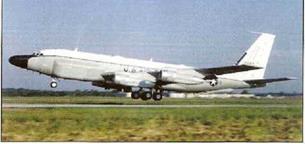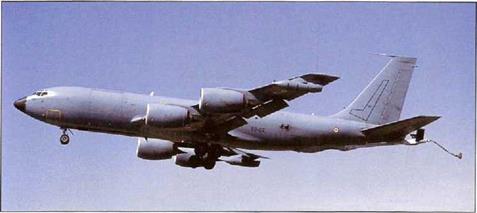Boeing C-135 family
|
 |
 |
|
F |
ollowing Successful trials of the Boeing 367-80 transport prototype with a Boeing-designed ‘flying boom’ refuelling probe under the rear fuselage, the US Air Force placed an order for an initial batch of 29 KC-135A Stratotanker aircraft, in September 1955. These would be the first of a grand total of 732 to be built. The first KC-135A flew in August 1956 and the initial production Stratotanker was delivered to Castle AFB in June 1957. The last KC-135A was delivered to the USAF in 1965.
Two major turbofan re-engining programmes have since been undertaken. The first involved the conversion of 188 early-model aircraft to KC-135E standard, adding TF33 turbofans and wider-soan tailplanes. The thrust reverser-equipped TF33 allowed greater safety margins. The use of shorter runways and reduced noise pollution. The KC-135E, is 14 per cent more fuel efficient than the KC-135A and can off-load 20 percent more fuel.
The Boeing-developed KC-135R first flew in August 1982 and is the mainstay of today’s USAF tanker fleet. Over 400 these CFM56-powered conversions have been funded to date, with the first entering service in July 1984, The USAF’s specialist KC-135Q tankers (once dedicated to the SR-71 fleet), have now been re-engined as KC-135Ts and are used for F-117 support tasks. A KC-135R can off-load 50 percent more fuel, is 25 percent more fuel efficient, costs 25 per cent less to operate and is 96 percent quieter than a KC-135A.
About 550 KC-135S remain in service. Boeing also built another 88 C-135s of various kinds for special missions. The most important of these is the RC-135 family of reconnaissance aircraft. Current types include 15 RC-135V and RC-135W ‘Rivet Joint’ aircraft, and two RC-135U ‘Combat Sent’ aircraft These are all sophisticated electronic intelligence gathering platforms, with a range of tactical and strategic roles. There is also a single RC-135S ‘Cobra Ball’ aircraft, which uses high – powered optical systems to examine missile re-entry vehicles and satellites in low-earth orbit, All of the USAF’s RC-135s are attached to the 55th Wing, based at Offutt AFB, Nebraska,
KC-135 tankers have been exported to France (14 KC-135Fs now KC-135FRs) and Singapore (four KC-l35Rs). Approximately 544 USAF C-135s of all types will undergo the Pacer Crag cockpit and navigation systems upgrade (Crag stands for compass radar and GPS), in addition to acquiring TCAS and GATS/GATM capability, allowing them to operate within improved future air traffic control systems.
The USAF now has a fleet of 15 RC-135V and RC-135W aircraft, which are its most important signals and electronic intelligence-gathering assets.
 |
Boeing’s E-3 Sentry is the world’s largest and most capable AWACS (airborne warning and control system) aircraft. The EC-137D prototype first flew on 5 February 1972. followed by xhe first E-3A on 31 October 1975. Using the airframe of a 707-3208 airliner fitted with a radar ‘rotodome’ and an extensive crew of mission operators, the E-3 is a flying C3I Command, Control, Communications and Intelligence) platform. E-3s are used to control the ‘air battle’ monitoring all airborne activity and controlling combat operations over a wide area, At the heart of the system is the AM/APY-2 Overland Downlook Radar, which is capable of tracking up to 600 low – flying aircraft. Since entering service. Sentries have been involved in combat operations in Grenada 11983), Lebanon (1983), Panama (1989) and Iraq (1991) and continuing operations in the Balkans.
Twenty-two E-3 As and two EC-137Ds, collectively termed ’core" aircraft when they were standardised in the late 1970s, were upgraded to E-3B level with faster computers. ECM-resistant communications and additional radios and display consoles. The first E-3B was redelivered in July 1984. In 1984, 10 E-3As were modified to E-3C siandard with a larger crew capacity, most E-3B equipment and ‘Have Quick’ communications equipment. All but the first 25 E-3
The large bulges which have been added to upgraded NATO and USAF (Block 30/35) E-3s house the new AN/AYR-1 ‘Quick Look’ ESM/Elint system.
airframes have inboard underwing hardpoints. E-3A ‘standard’ versions have been delivered to Saudia Arabia (five) and NATO (18). The USAF has 33 E-3s.
Both US and NATO aircraft have undergone recent upgrades to enhance their capabilities, and add new electronic surveillance systems. US Sentries have undergone The Block 30/35 Modification Program, which includes an electronic surveillance capability to detect and identify air and surface-based emitters, the JT1DS datalink, increased computer memory end GPS navigation. In addition, a five-year U. S./NATO Radar System Improvement Program (RSIP) was launched in 1999 RSIP involves major hardware and software modifications to the existing racar system.
Improved and re-engined Sentries have oeen delivered to the UK (seven E-3D Sentry AEW. Mk 1) and France (four E-3F SDA (Systeme de Detection Aeroportee)). Both versions entered service in 1991 and are powered by CFM56 turbofans. They are also fitted with IFR probes, in addition to the standard E-3 inflight-refuelling receptacle. RAF aircraft have wingtip-mounted Loral Yellow Gate ESIYI pods (becoming the first E-3s with this capability) CFM56 engines also power the five E-3As and eight KE-3A tanker aircraft, acquired by Saudi Arabia.

|












